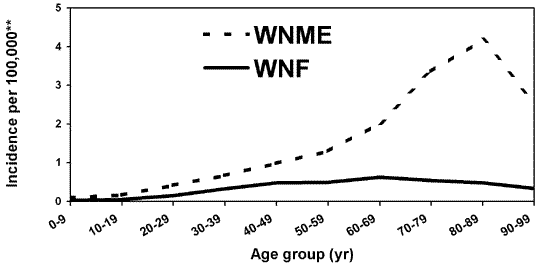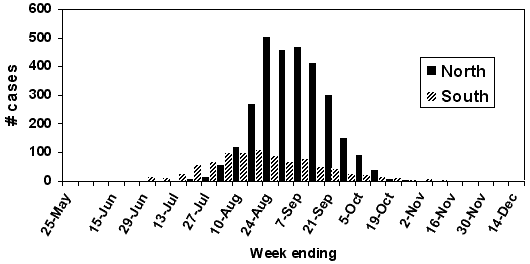No, this bug doesn't prefer farmers to city folks, but there are some issues you might consider.
This virus is a close relative of some heavy-hitters responsible for thousands of deaths over the years: Yellow Fever, Dengue and Japanese Encephalitis, just to mention a few.
All of these diseases are spread by the bite of infected mosquitoes, only now the mosquitoes infected with West Nile virus are right here in Yuma County.
The standard scenario for virus transmission is for the mosquito to acquire
an infective dose of virus in a blood meal taken from a bird. The threshold
for a mosquito to be infected from a blood meal is 100,000 virus particles
per ml of blood. Many bird species do not produce a sufficiently high
a level of circulating virus. Some do however, and some of the best virus
producers are abundant in the desert southwest, and include finches and
grackles.
Once taken up in a blood meal, the virus must infect the mosquito, become
disseminated throughout its tissues, and be secreted in saliva during
a subsequent blood meal. This happens to a greater or lesser degree according
to the mosquito species, ambient temperature and the initial virus dose.
US Army researchers at USAMRIID have looked at what kinds of mosquitoes are efficient vectors of West Nile virus, and found some very disturbing facts. The most efficient vector evaluated so far appears to be one of the most abundant species along the Colorado and Gila rivers; Culex tarsalis.
Infection and dissemination rates for mosquitoes that ingested 107.0 +0.5 PFU/ml of West Nile virus
| # Tested | Infection rate (%) |
Dissem rate (%) |
|
|---|---|---|---|
| Cx. tarsalis | 71 | 96 | 86 |
| Oc. triseriatus | 28 | 32 | 25 |
| Cx. pipiens | 95 | 81 | 23 |
| Ae. vexans | 75 | 44 | 17 |
Cx. nigripalpus |
127 | 84 | 12 |
| Ps. ferox | 24 | 33 | 0 |
Department of Vector Assessment, Virology Division, USAMRIID
Fortunately, Culex tarsalis is most often found in riparian areas
along the rivers, but it is also abundant along drainages where there
is emergent vegetation, and in areas where tailwater collects for an extended
time. If you observe cattails growing in areas of standing water, expect
Culex mosquitoes to be breeding there. Culex mosquitoes,
including the more "suburban" species called Culex quinquifasciatus
will breed enthusiastically in horse or pet water troughs, culverts or
any dirty standing water. If you have standing water with cattails growing
in it on your property, now may be the time to deal with it before you,
a family member or employee is exposed to this virus. Be sure to use mosquito
repellent containing DEET when in mosquito infested areas.
Feel free to call either the Yuma County Pest Abatement District at 726-1030 or Yuma County Health Department at 317-4584 for advice and treatment options.
If you have livestock, dump the water at least every week or stock the troughs with mosquito fish also available from YCPAD at no cost.
Remember, you as a landowner are responsible for mosquitoes breeding on your property. Please take the time to check for mosquito breeding sites, and feel free to ask for assistance from the above agencies.
The West Nile infection in horses is deadly. About 1/3 of infected horses will die or have to be euthenised. This can be avoided with a vaccination available from local large animal veterinarians.
West Nile infection in humans is reported as either West Nile fever, which is the more common mild set of symptoms, which includes fever, headache, body ache, occasionally rash on the body trunk and swollen lymph glands, or as the more severe West Nile Meningo-Encephalitis (WNME). The latter occurs in less than 1% of infected people but includes severe head and neck pain, meningitis, encephalitis, tremors, flaccid paralysis, coma and death. Older people are at increased risk from the more severe form of the disease as shown below:
Human WNV Disease Incidence, by Age Group and Clinical Category, United States, 2002*

In all of last year, CDC reports that there were 4,156 human cases, and
284 deaths. So far this year there have been over 1764 human cases and
32 deaths reported as of September 2nd. This puts us ahead of this time
last year. The chart below shows that last year, the bulk of the West
Nile cases were reported during the month of September.
West Nile Cases Reported by Week (2002)*

*Grant L. Campbell, M.D., Ph.D., Division of Vector-Borne Infectious Diseases,
National Center for Infectious Diseases, Fort Collins, Colorado.
In summary, here are some things you should do:
*Eliminate mosquito breeding sites wherever possible
*Avoid human exposure to mosquitoes*Get horses vaccinated
*Use repellent containing DEET, wear long sleeves/pants
*Report mosquito activity to control agencies
For more information call YCPAD at 726-1030. On-line information on West
Nile surveillance in Arizona is available at:
http://www.hs.state.az.us/phs/oids/westnile/wnv_update.htm
Additional on-line West Nile information is available at:
http://www.cdc.gov/ncidod/dvbid/westnile/
http://westnilemaps.usgs.gov/
Issued in furtherance of Cooperative Extension work, acts of May 8 and June 30, 1914, in cooperation with the U.S. Department of Agriculture, James A. Christenson, Director Cooperative Extension, College of Agriculture and Life Sciences, The University of Arizona.
The University of Arizona is an equal opportunity, affirmative action institution. The University does not discriminate on the basis of race, color, religion, sex, national origin, age, disability, veteran status, or sexual orientation in its programs and activities.
Any products, services, or organizations that are
mentioned, shown, or indirectly implied in this web document do not imply
endorsement by The University of Arizona.
Information provided by:
Barry Bequette, plantdoc@ag.arizona.edu Extension Agent, Urban Horticulture
Barry Tickes, btickes@ag.arizona.edu Extension Agent, Yuma County
Mohammed Zerkoune, zerkoune@ag.arizona.edu Extension Agent, Agriculture
University of Arizona, Tucson, Arizona.
Material written September 2003.
For more Arizona Production Ag Information:
Home | Cotton | Veggies| Forages | Grains | Citrus | Crop x Crop | Insects | Diseases| Weeds | Pesticides | News | Weather | Research | Photos | Contacts | General Info. | Site Map
document located at: http://cals.arizona.edu/crops/counties/yuma/farmnotes/fn0903westnile.html
Copyright © 2001 University of Arizona,
College of Agriculture and Life Sciences
Webmaster: Al Fournier (fournier@ag.arizona.edu)